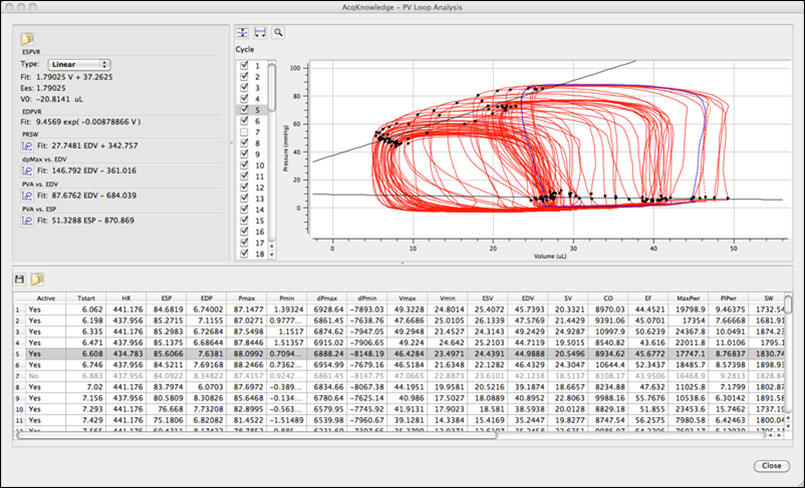120 – X/Y Loop Area Analysis
This application note covers manual area calculations of X/Y Loops. For completely automated Pressure-Volume Loop Recording and Analysis, including per-loop and statistical measures, see the new AcqKnowledge 4.3 Pressure-Volume Loop Analysis Package.
Area calculation of X/Y loops is commonly required for a variety of physiological investigations. Significant among these is the pressure/volume relationship manifest in hemodynamic and pulmonary measurements. In these cases, the area of the pressure/volume loop increases in proportion to the power exerted or work performed.
For quick determination of work performed, the loop display offers an immediate visual advantage over the conventional time domain presentation of the pressure and volume data. One can more easily see if the work performed has increased or decreased by simply visually inspecting the loop size.

Complete Automated PV Loop Analysis Available as a Licensed Feature in AcqKnowledge 4.3 and above.
Associated Applications
- Psychophysiology - Record and analyze BP, ECG, HRV, EDA, EMG, EEG, EOG, RSP, etc. Interface to stimulus presentation programs...use automated analysis routines to easily score and analyze data.
- EOG: Eye Movement - Record eye position and movement with the EOG100C amplifier. Find frequency, distance, velocity, and point of focus. Isolate behavior associated with nystagmus and saccades.
- Cardiovascular Hemodynamics - Hardware for human and animals. Measure continuous BP, ECG, stroke volume, cardiac output, PPG, etc. For animal and tissue look at acute and chronic dose-response.
- Respiration | Pulmonary Function - Perform lung volume measurements, examine pressure/volume relationships, and analyze respiratory gases. Use AcqKnowledge to integrate airflow and analyze data.
- Exercise Physiology - Examine ventilation, oxygen uptake, carbon dioxide production, biopotentials, temp., and biomechanical signals simultaneously. Record wirelessly with BioNomadix.
- Biomechanics - Use BIOPAC equipment for gait analysis, goniometry, ergonomics evaluation, range of motion, EMG, Remote Monitoring or to interface with third-party equipment.
- Remote Monitoring - BioNomadix modules provide high quality, full-bandwidth data for a variety of signals—ECG, EEG, EGG, EMG, EOG, PPG, RSP, SKT, Accelerometry, Cardiac Output, Dynamometry, and Heel-Toe Strike.
- Amplifiers & Interfaces - Use BIOPAC amplifiers with MP Systems, as stand-alone devices, or with 3rd-party flow meters, force plates, sono-micrometers, telemetry equipment, metabolic carts, etc.
Stay Connected